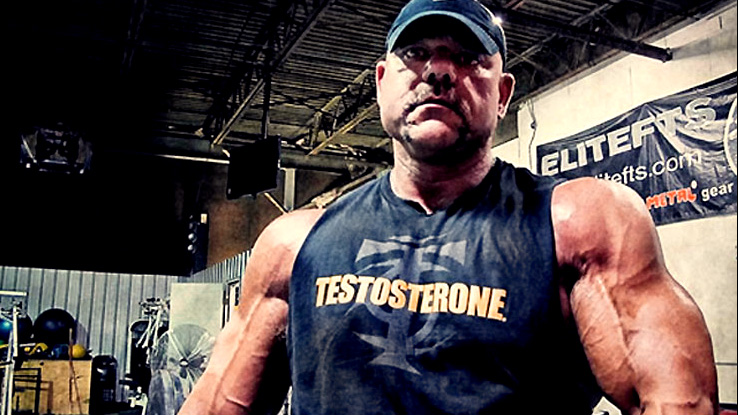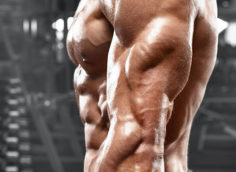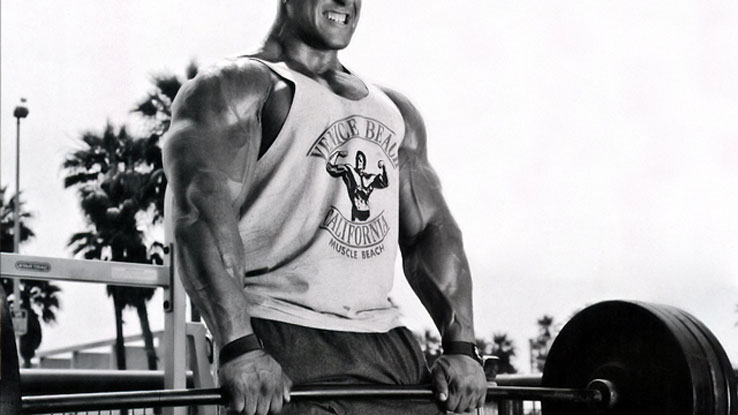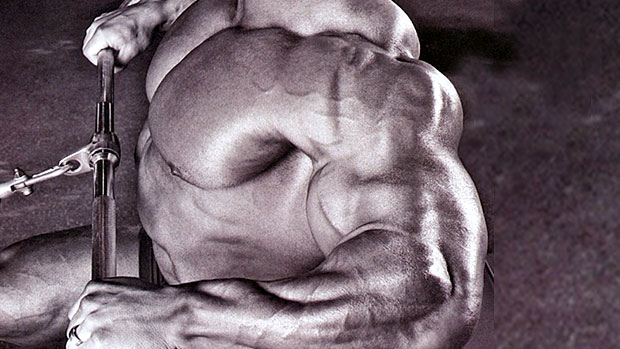This Tool Box series has become one of my most popular article sets to date, so why break with what's working? Here's the latest installment of this series designed to help experienced lifters fill in the blanks and learn the finer points of strength development.
De-loading Bench Press (with Weight Releasers, Chains and Bands)
Category: Max Effort
Muscles Targeted: Chest, Shoulders, and Triceps
Exercise Description: A few years ago, Louie Simmons of Westside Barbell Club wrote an article about using de-loading weight releasers for a special max effort method we were using for the box squat. I've spent the past year trying to find a way to use this same method with the bench press.
It's taken a year because this method is so demanding on your system that it can’t be used very often. It was also a complicated process (complete with a couple of injuries) finding the right loading parameters. What I've found is this: what works for the squat doesn't always work for the bench press. So I had to start from scratch. I've also found that the only way to determine the correct parameters is to get under the bar and find out what works best.
This loading process turned out to involve weight releasers, bands, chains, and barbell weight.
 |
A weight releaser
I'll discuss the reasons why in just a minute. First, let me discuss what we're trying to achieve. The goal is to get the weight at the top of the movement over 100% of your best shirt max, then, as you lower the bar, begin the de-loading process. Once the bar hits your chest you'll then lose the chain weight as well as the weight on the weight releasers. As you press the bar back up, the bands will "reload."
 |
Confused? I can see why. This is how I felt at first. Here's the main thing: We all know the power eccentric training can have on strength development, but at what expense? You see, with negatives you don't accommodate for the strength curve.
Let’s say you can bench press 400 pounds. You decide to do eccentric training. Many of us have been taught to do this by overloading the barbell and then lowering it slowly. First off, while you may have over 100% of your max at the top, this 100% represents your max strength of the entire lift, not what you can lift at the bottom. It may be 100% at the top, but what is it at the bottom of the lift?
We all know you're stronger at the top, so the weight at your weakest point can be too much, which can lead to injuries. We also know that for eccentric strength to be effective it needs to be done at a normal to fast speed, not slow. This is the reason for plyometrics in the first place.
Now, even if you use weight releasers to overload the movement, the same is still true. With weight releasers you can add extra weight to the barbell that'll then pop off at the bottom of the movement, thus allowing you to press the bar back to the top.
So we now know you need to have some bands for the fast eccentric as well as extra loading at the top. We also know to press the bar back up, thus taking advantage of the explosive reactive strength we need to lose much of the bar weight. Finally, we need to find a way to de-load the eccentric to accommodate for the strength curve. This can be done by placing the chains on the weight releasers so they de-load on the way down and then pop off with the weight that's on the releaser.
In summary, you have a set weight on the barbell with band tension. Then you add weight releasers to the bar that have a combination of straight weight and chains. Now you have a max top weight, a de-loaded weight, a weight at pop-off (when the bar is on your chest after weight releasers has been popped off), and the re-loaded weight at the top.
Now you can see the hell I had to go through to get this right. After several tries I feel we finally figured out how to make this work. Here are the percentages we've found to be effective. These are based on your best raw bench press max:
Band tensions — 80 pounds at top. This is one double mini-band, around 40 pounds at bottom. This is good for all strength levels for this method.
Barbell weight — 50%
Weight on weight releaser — 20% total. 10% for each side.
The chains will be added as you work up.
The set/rep scheme works like this: Begin with the band on the barbell and slowly work up making sure to get an adequate warm-up. Work up to 50% on the barbell with straight weight. Yes, the 50% includes the weight of the barbell, but not the tension of the bands. Three reps per set is what I'd recommend as you work up.
After you reach 50% for your first set of 3 reps, you'll add the weight releasers with 10% plate weight per side for one set of one rep. Now you'll begin to add one chain per weight releaser for each additional set. See picture above to see how they're placed on the weight releaser. Basically, we have a large carabineer hook in the middle of all the chains we sell. This hook fits over the weight releaser so there's an even de-load on each side.
Hint: It's very helpful to use one or two big spin-lock collars on the weight releaser before you place the chains. This keeps the chains at a higher level off the floor allowing for a better de-load. If you don't have a set of these, then you can use a ton of 10’s, 5’s and 2.5 pound plates for your plate weight. This will accomplish the same thing.
With each additional set, add one more chain per side for one rep per set. Don't try to lower the barbell slowly. Let the bar fall as you would a normal bench press set. It really doesn't need to be faster or slower than this.
As you work up you should feel like this is an ass-load of weight at the top while holding the barbell, then as you break your elbows you'll begin to feel the de-load. If you set the weight releasers up correctly they'll pop off right above your chest (better yet, on your chest).
Hint: Set these up before you warm-up. When the bar hits your chest and the weight releaser pops off you'll feel the weight release and a huge surge of explosive strength. This is another reason for the band tension. You need something to slow the bar down on the way up or you'll toss the bar through the roof! Seriously, you need to have the tension so you don't get hurt with the explosive force you'll be developing.
When all is said and done, you'll hit some huge numbers. First, the total weight at the top may end up being around 140% of your raw max. (Very close to many of your bench shirt maxes. My goal was to get this top holding weight as close to my shirt max as I could.) The weight at your chest before drop-off will be around 80-85% of your raw max. After drop-off this will drop to around 55-60%. The reloaded weight at the end of the press will finish up around 70% of your best raw max. You may have to play around with the percentages to get it to work right for you, but this at least gives you a great place to start.
So what will this do for you? First, it'll help build a strong start. You have to be able to hold and control the weight at the top of the press. For me, this is everything. Most missed lifts I see happen because the start got messed up.
Second, it'll teach you to lower heavy weight under control. This is also key for making sure you hit your chest (or belly) in the correct place during a max lift. Third, if you think about it, this is also how a great bench shirt will work. It'll feel heavier at the top, then the shirt begins to take the weight. At the chest you get an explosive start and then have to push through the top.
Finally, it'll build incredible reactive and explosive strength.
Training Mistakes:
• Using too much band tension. Start with the double mini. If you think you need more, move up slowly.
• Using too much weight releaser weight. This causes the eccentric weight before drop-off to be too high and can lead to overuse injuries at the bottom part of the movement.
• Dropping the bar too slow. Keep the speed the same as normal bench press speed.
• Not holding the bar at the top. This is both for the start and finish. Take advantage of the added training effect of the huge top weight at the start and hold the bar for one or two seconds. I like to hold mine for a three count.
Reverse Band Press
Category: Max Effort, Restoration
Muscles Targeted: Chest, Shoulders, and Triceps
Exercise Description: Made famous by Louie Simmons, the reverse band press has been around for some time now.
 |
I still remember the first time we did this movement. We set the bands up from the top of the rack so the barbell was being suspended by the bands. We used a strong Jump Stretch flex band for this. We found it took around 145 pounds for the barbell to touch our chests with a seven foot power rack.
I was excited as hell to do this. Who wouldn't be? You now have a band helping toss the weight off your chest. I was all jacked up thinking about the huge weight we'd be lifting. Then, as we worked up, something strange happened. The weight got freakin' heavy! The bands didn't help so much at lockout. Next thing we knew we had a great training device to bring up a lifter's lockout strength. This has since become a staple of our training.
Some days we'll use an average band and on others a strong band. This movement became part of the great max effort mix of the floor press, board press, chain press, close-grip inclines, and rack lockouts. Our arsenal was growing and has been growing ever since the first day I stepped into the gym.
To do the max effort reverse band press, all you do is anchor the band around the top of your power rack, load the bar, and work up. Many lifters like to do this for 5, 3 or 1 rep maxes. This just depends on what works best for you. This is really all there is to it.
Here's one of the 50 bench cycles I've listed in the Dynamic Bench Manual. This is one of the ways I've used the reverse band press for injury recovery and restoration.
Post Injury Phase — Reverse Band
Application: This cycle is intended for recovery and post-injury training. The weight and band should be set up so there's zero weight at the chest. You'll have three options:
1. Light band and 65 pounds
2. Average band and 95 pounds
3. Strong band and 135 pounds
This is one of the best post-injury cycles we've seen. The key to making this work is to let the band do most of the work and keep the muscle tension to a minimum. This workout should be done every bench day until your strength begins to return. This is also a great restoration workout that can be used during regular training phases at the end of the entire session.
Post Injury Training
Weeks 1-3:
2-4 times per week: 1-2 sets, 100 reps
This is to replace the regular bench training.
Restoration Training:
1 set, 100 reps
This is to be completed at the end of your workout on bench training days.
Box Squat with Chains
Category: Dynamic Effort and Max Effort
Muscles Targeted: All
Exercise Description: The first thing is to learn how to box squat. The article, Squatting from Head to Toe, can help you with this.
Squatting with chains can help you to develop great explosive strength. This is because the chains will be set up in such a way to allow de-loading of the barbell. This will enable you to handle more weight at the top than you're handling at the bottom. You have to bust ass out of the bottom so you can explode into the chain weight as you stand up.
 |
With the huge overuse of bands in recent times, I feel many are losing out of the great training effect chains can have. It can be argued that bands are better, but everything can lose its training effect in time. Plus, you need a break from the bands from time to time or you'll get beat up. I don’t care what anyone says; I've seen it happen far too often. While I agree bands are great and should be used, they also need to be cycled intelligently.
There are some people out there who do know how to cycle band tensions, recovery time, and loading parameters, but for the most part they're the minority. If you've been on bands for a very long time, try to run a cycle of chains and you'll see what I mean. They worked in the past and they still work today.
Here's an example of a Dynamic Effort chain cycle:
Old School Westside with Chains
Application: Very good cycle for pre-meet training or pre-testing for the intermediate lifter.
Training Cycle:
Week 1 — 50% for 12 sets 2 reps
Week 2 — 52.5% for 12 sets 2 reps
Week 3 — 55% for 12 sets 2 reps
Week 4 — 57.5% for 10 sets 2 reps
Week 5 — 60% for 10 sets 2 reps
Suggested Chain:
Squat Max: 200-400 Pounds — 60 total pounds of chains
Squat Max: 400-500 Pounds — 80 total pounds of chains
Squat Max: 500-600 Pounds — 100 total pounds of chains
Squat Max: 600-800 Pounds — 120 total pounds of chains
Squat Max: 800-950 Pounds — 160 total pounds of chains
Notes:
• Chains should be set up so 2-4 chain links are on the ground at all time. The chain setup should be the same as sold by EliteFTS. There should be a feeder chain to adjust the chain length.
• If you feel good after your sets, work up to a heavy double. This shouldn't be done every week but should be completed at least twice through the cycle.
• Training percent is based on current one rep max with the free squat with equipment.
• These percents are used as guidelines. The more advanced the lifters, the lighter the percent needed. If you're a raw lifter or don't use power lifting gear, then a minimum of 10% should be added to the listed percents.
• All sets should be performed with the use of a parallel box.
• You should rest no more than 45 to 60 seconds between sets.
Board Press with Bench Shirt
Category: Max Effort
Muscles Targeted: Chest, Shoulders, and Triceps
Exercise Description: The board press was already covered in the first Tool Box article, but I'd like to go back and revisit this from the perspective of board pressing with a bench shirt.
I do understanding most T-Nation readers don't bench press with a shirt and more than likely never will. I also feel I need to pass on a very important lesson I learned about this style of board pressing to save others from making the same mistake I did. I'll break this down as the good, bad, and ugly.
 |
The Good
There are many good reasons to board press with a shirt, and these were the reasons I decided to begin doing them. First, I really didn't have any idea how to get the most out of my shirt. I wasn't wearing tight enough shirts, I didn't start the bar correctly, and I didn't lower the bar in the middle of the "bubble." By this I mean I didn't keep the bar in the tightest part of the shirt.
I also had a weak lockout that had to be corrected. The problem I've had in the past with shirt training is that my strength level varies depending on how far out I am from a meet. For example, if I'm 16 weeks out I can’t bench anywhere close to a record. My training is not geared toward this at that time. I'm strong for four to five weeks at best before a meet.
With a gangster shirt (a very tight, jacked up shirt) it'll take more weight to touch than I'm capable of handling in the off-season, so shirt training is out of the question for me. Plus, my shoulders can only handle it for so long. With a 2- or 3-board, I'm able to get the bar to touch in the off-season regardless of how tight the shirt is. This enabled me to learn the start of the lift as well as lowering the bar in the bubble. It also allowed me to bring up my lockout strength very fast.
 |
A 2-board press tool
I exclusively used shirt board pressing for close to six months for max effort work. I did this so I could finally learn the shirt and bring up my lockout power. Each week I'd change the parameters. I'd vary the reps from 5, 3 or singles as well as using a 3, 2 and 1 board. Every week would be something different and when I began to feel beat up I'd take the week off max effort work. The good thing was I wasn't getting beat up. The shirt was protecting my joints from the heavy loads.
So, in summary, the good aspects of this were:
1. I didn't get beat up as fast.
2. I increased my lockout strength.
3. I was able to fix my start of the lift.
4. I finally figured out how to lower the bar.
Using the Metal Viking shirt also made a big huge difference for me because of the shoulder stability the shirt provides.
 |
The Bad
While the benefits did make a huge difference in my training and strength, there were some flaws I didn't see at first. Louie and some of my other friends kept trying to tell me but I wouldn't listen. I was living in the Go Heavy Zone and loved being able to handle big weights off boards.
With the training I was doing, I didn't do any standard max effort training. Because of this, my raw bench strength took a huge dive. I knew this but didn't care because my shirt strength was going up. Screw it, raw strength doesn't count on the platform, and I also wanted a huge carryover like some of the other guys were getting. If I lost 50 pounds on my raw bench to do this, then so be it.
I found out later that this does matter, not only in recovery but in your ability to bring weights to your chest. This brings me to my second problem: I never brought a single weight to my chest with the shirt, not one time in the six months of doing this. The lowest I ever went was to a 1-board.
What the hell, I figured. I could always bench the same off 1-board with a shirt as I could in a meet. I was jacked up because I had a 700 pound 1-board in training (95 pounds over my best competition bench) so I figured I'd do the same at the meet.
The Ugly
Meet time finally rolled around and I found out real fast how wrong I was. I had to open with 645 if I had any chance of getting the bar to touch. Once again I was wrong. The weight felt very light but stopped about four inches from my chest. I pressed the bar back up and called for 700 on my second attempt.
Once again the bar didn't touch. This time it was about an inch away. I pressed it back up and called for a repeat on my third. Finally, it did touch (I know, I took 95 pounds better than my best to touch). This time I did press it back up and fell short at lockout.
Yes, I was stronger, but I had no idea how to touch the weight to my chest! Thinking back, how could I know? I never did it in training. The shirt was jacked up to the max and tight as hell but I still should've been able to touch my opener if I knew what I was doing. I should've learned this in training and I should've listened to my training partners.
The Solution
This is a hard call. There were great benefits to what I did and I'll do it again as it did teach me how to use the shirt and bring up my lockout. I feel that for me (you may be different) this type of training is best left for the off-season. As the meet rolls around you have to bring bars to your chest.
There are several options. I feel if you know your shirt and know how to touch, then you don't need to use your shirt as often as someone who doesn't know. Most of the big benchers at Westside put their shirts on one time per month and work up to their opener and stop.
This is the best thing for two reasons. First, it's working very well for them. I can’t even count the number of 700 pound benchers there are in the gym. Second, it gives you the other three weeks to work on true max effort training.
For those who don't know the shirt, I feel you need to use it more often, but not at the expense of your other training. If you don't take the time to learn the shirt then you'll leave weight on the platform. You need to do what you feel you need to do to learn the shirt, but make damn sure you do some work to your chest or you'll fall short in the end.
As I found out, nobody cares what you can board press in a meet!
Conclusion
If your progress in the big lifts has stalled, try a few of these exercises and bring up those weak points!
Note: For more info from Dave Tate, be sure to visit his site at www.elitefts.com and checkout his new book, Under the Bar.





